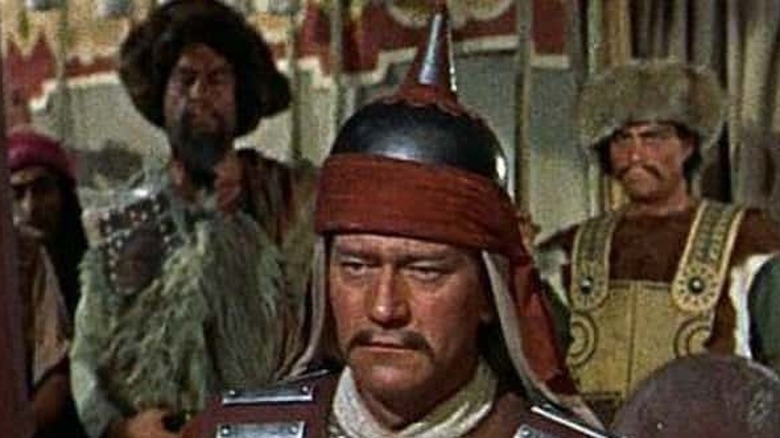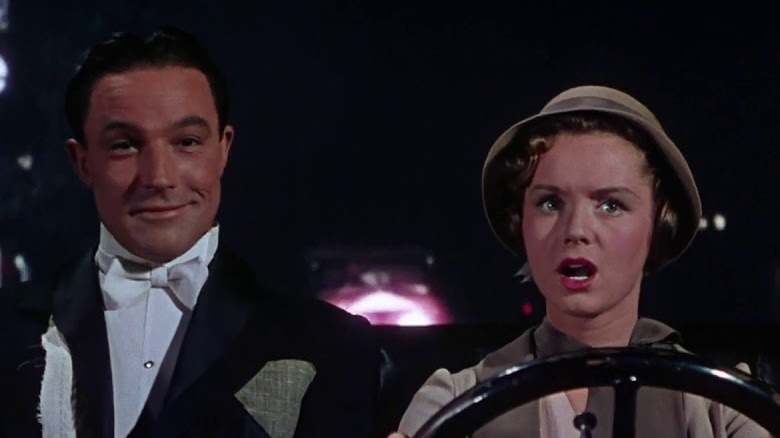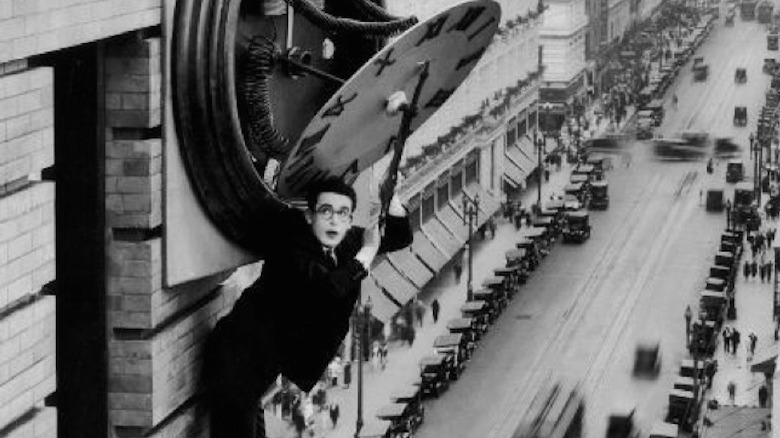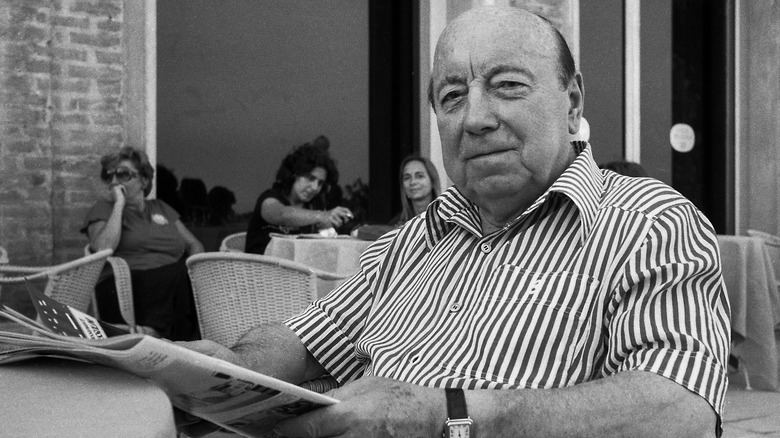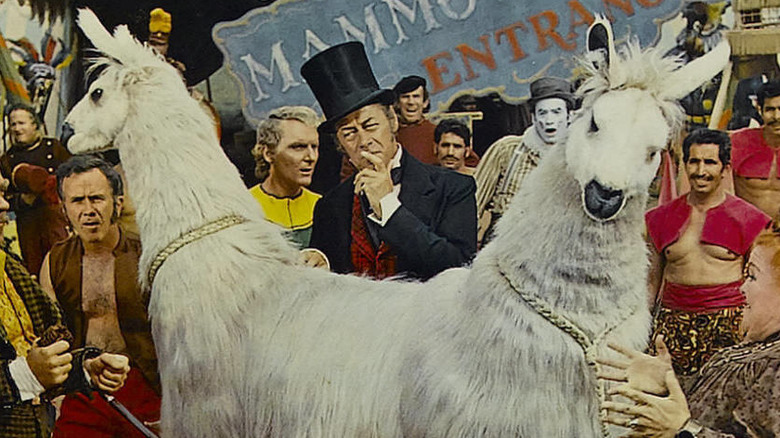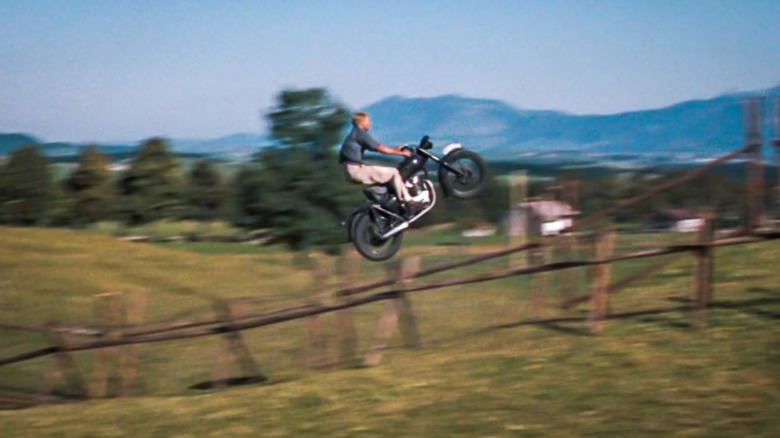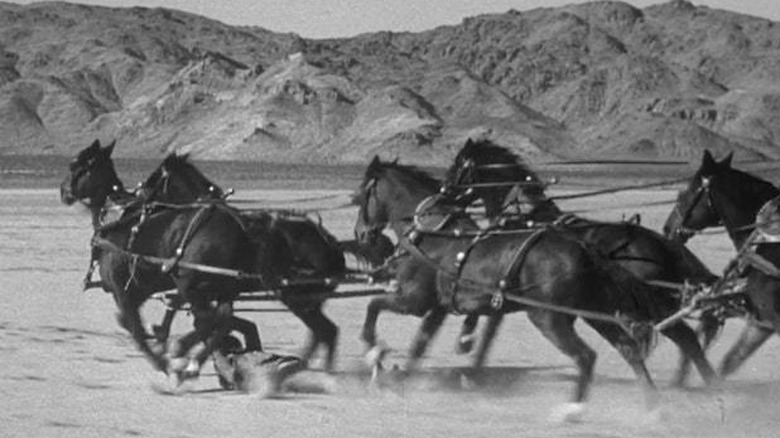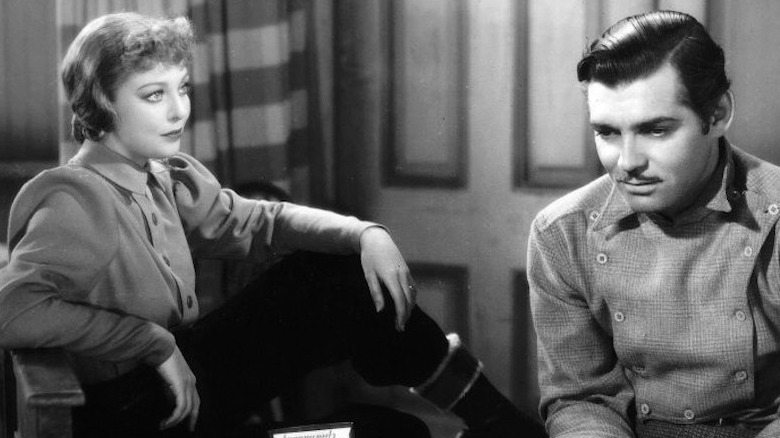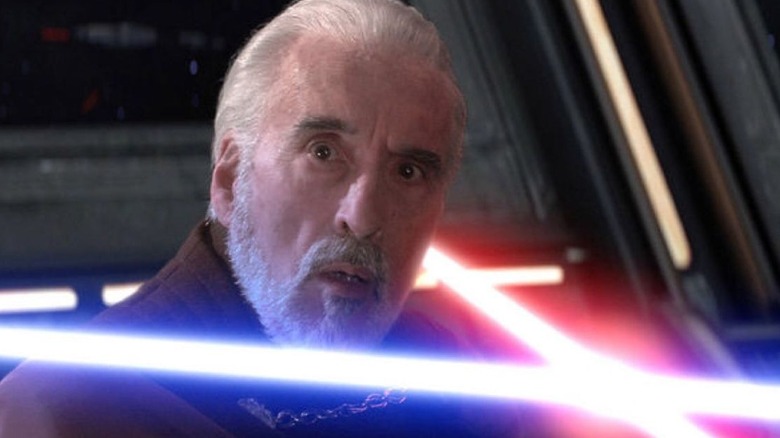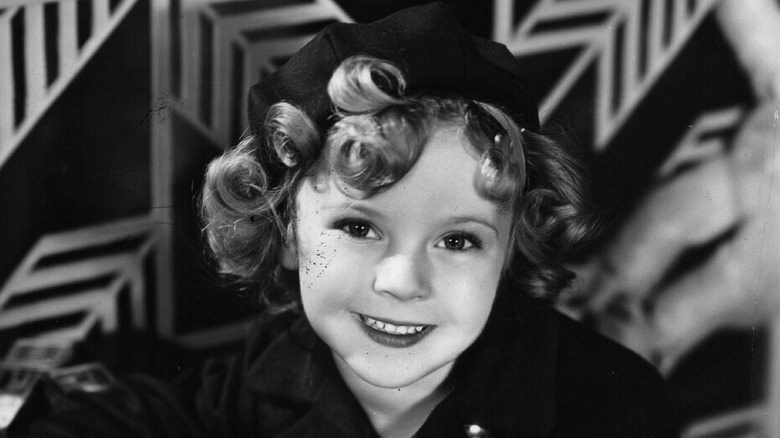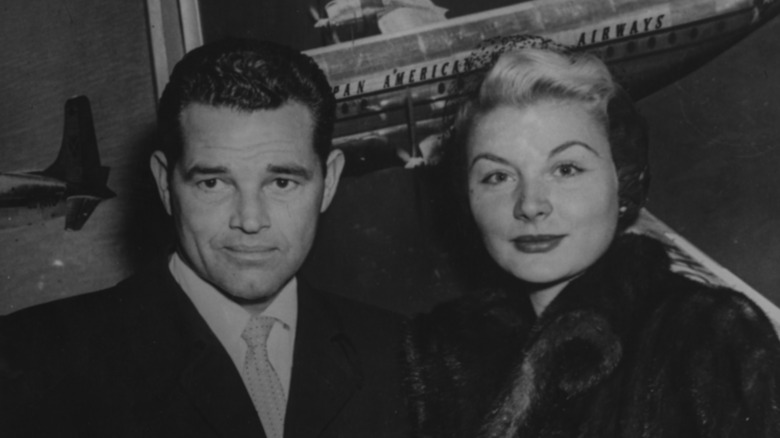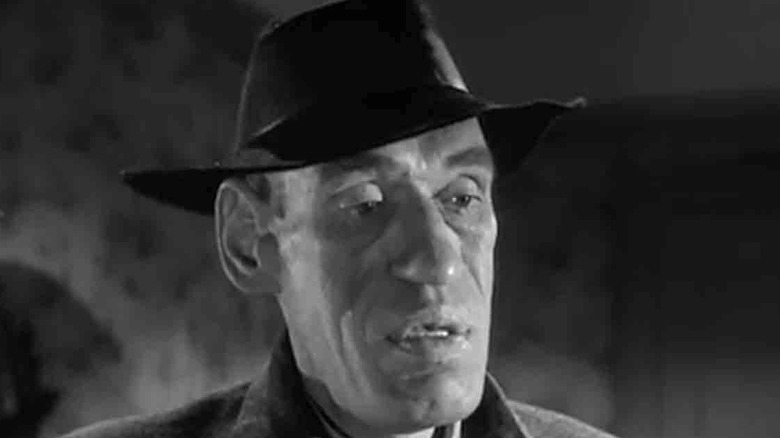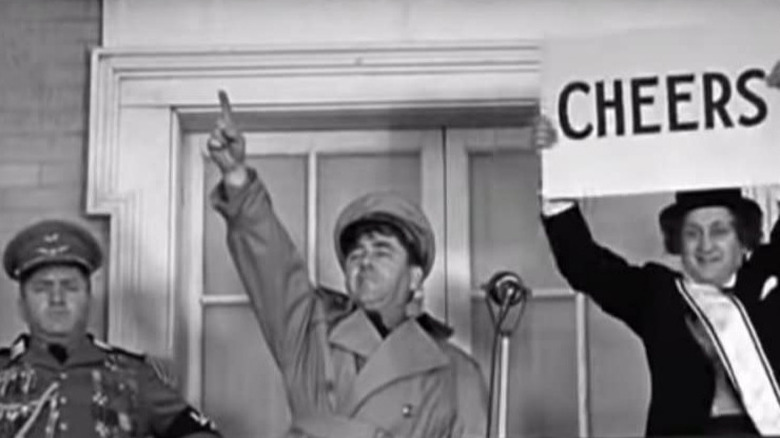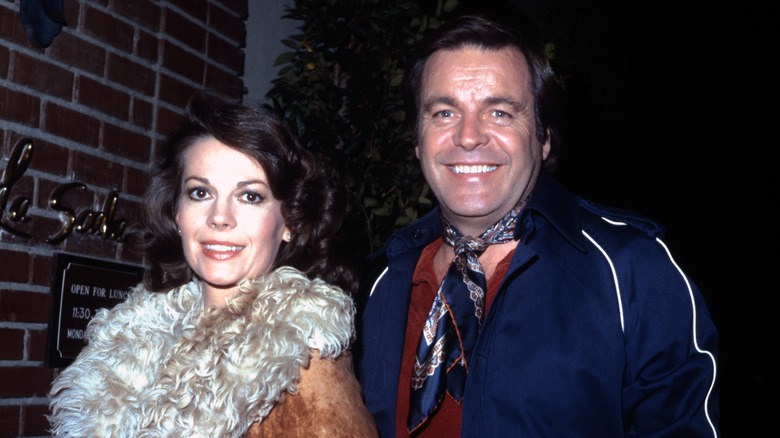Wild Stories From Classic Hollywood Films That Are Actually True
We may receive a commission on purchases made from links.
One of the most enduring nicknames for Hollywood is "the Dream Factory." It's an apt description for a town and industry that, historically speaking, mints unknowns as stars and breaks the famous and powerful with equal frequency and ferocity. Stories about the classic Hollywood period — the silent era, the Golden Age (1930-1945), and the postwar years before the tumultuous changes of the New Hollywood in the 1970s — abound with magical ascents to fame and fortune, astounding productions, performers that captivated audiences, and shocking scandals that defied societal standards and even the law. In short: They fulfill all the criteria for a dream, or a nightmare.
You could spend a lifetime tracking down every wonderful, wicked, and weird Hollywood story. However, we've done the legwork for you and pulled some of the wildest stories about classic Hollywood on record for this spoiler-filled list. And best of all, every one is true.
The following article includes allegations of sexual assault.
Howard Hughes' The Conqueror was filmed near a nuclear testing site
The most unbelievable thing about the 1956 film "The Conqueror" isn't the sight of John Wayne in a Fu Manchu mustache as the Mongol warrior Genghis Khan, or its yellowface casting and absurd dialogue. No, it's the fact that producer Howard Hughes chose to shoot many of the exteriors in regions of Utah that were downwind from nuclear testing sites. More than 90 people who worked on the film were subsequently diagnosed with cancer, and more than half of that number died of the disease.
The grisly statistic was revealed in a 1980 issue of People magazine, which noted that 91 members of the 220-person cast and crew had contracted some form of cancer after the release of "The Conqueror." Among those who died of the disease were Wayne, co-stars Susan Hayward, Agnes Moorhead, John Hoyt, Lee Van Cleef, and director D. Powell. Pedro Armendariz, who played Wayne's rival, took his own life after learning that he had cancer. Ultimately, none of the deaths were ever directly linked to the "Conqueror" location; it's possible, for instance, that Wayne's death may have been due to his four-pack-a-day cigarette habit.
But the mortality rate among the cast and crew was uncommonly high enough for Dr. Robert C. Pendleton, director of the radiological health department at the University of Utah, to tell People, "With 91 [cases], I think the tie-in to their exposure on the set of 'The Conqueror' would hold up even in a court of law." A study of Mormon residents in the three-state fallout zones around the testing sites found that levels of leukemia were five times higher than among those in other areas — a fact that couldn't be attributed to tobacco or alcohol, due to their religious abstinence.
Singin' in the Rain was anything but sunny for Debbie Reynolds
The 1952 musical "Singin' in the Rain" is one of the most beloved Golden Age Hollywood movie musicals, ranking fifth on the American Film Institute's "100 Greatest American Films of All Time." But for co-star Debbie Reynolds, the experience was anything but joyful.
Only 19-years-old at the time she was cast in the film as lead and co-director Gene Kelly's girlfriend, Kathy Selden, she was an accomplished singer but a novice at dance, while both Kelly and co-star Donald O'Connor were acknowledged masters. As a result, Reynolds had to work twice as hard as her screen partners to meet their level of expertise. "I had three months to learn what Gene Kelly and Donald O'Connor had been doing for years," she wrote in her 2013 memoir Unsinkable.
According to Reynolds, rehearsals for "Singin' in the Rain" were a punishing experience. "[Kelly]... criticized everything I did and never gave me a word of encouragement," she wrote. Filming proved even more difficult: the four-minute musical number "Good Morning," which featured all three actors, took 15 hours to complete, rendering Reynolds nearly immobile with bleeding feet. Doctors put her on bed rest for two days after the scene was completed.
Exhausted both physically and emotionally, at one point Reynolds fled rehearsals. Legendary screen dancer Fred Astaire found her in tears under a piano and invited her to watch him rehearse a routine until he was exhausted and drenched with sweat. As Reynolds told the American Film Institute, a sweat-drenched Astaire said, "You see how hard it is? It never gets easier." Reynolds rallied and completed the film, which would become an iconic musical title, still beloved by audiences decades after its initial release.
Silent star Harold Lloyd hid two missing fingers
Though perhaps not as well remembered today as Charlie Chaplin or Buster Keaton, actor Harold Lloyd was every bit as popular and innovative a comic performer during the silent era. He was known for his accident-prone, bespectacled screen persona and comedies filled with sight gags and physical stunts — but Lloyd's stardom was nearly derailed in 1919 by a freak accident.
During a publicity shoot for a new series of two-reel comedies, Lloyd picked up what he thought was a prop explosive and lit the fuse with a cigarette. The prop exploded, severing the finger and thumb on Lloyd's right hand and leaving him temporarily blinded. Though he would regain his sight, there was significant concern that the injury would spell the end of his movie career.
So, Lloyd worked overtime to convince audiences that both his comedic skills and his hand were intact. He continued to fuel his productions with death-defying stunts, the most notable of which is the now-iconic scene from 1923's "Safety Last," in which Lloyd appears to hang several stories over downtown Los Angeles from the hands of an oversized clock. For this scene, and in many others that followed, Lloyd wore a glove that concealed prosthetic digits in the place of his missing fingers. The glove was designed by director Hal Roach and producer/studio chief Sam Goldwyn, who had worked in the glove business prior to his Hollywood career.
Lloyd succeeded in keeping his injury out of the public eye; publicity photos taken after 1919 often showed him with his right hand in his pockets. In fact, the only indication the public might have had about Lloyd's disability was his handprints in the sidewalk outside Grauman's Chinese Theater, which he made in 1927. As the blog Silent Locations noted, the impressions of his thumb and forefinger on his right hand are not as deeply pressed into the cement as those on his other hand.
Marcel Carne protected his cast and crew from the Nazis
Every filmmaker faces challenges during the production of a movie, but few have contended with the life-or-death struggles faced by French director Marcel Carne during the making of his 1945 film "Children of Paradise." The Oscar-nominated film — a lyrical romance included on Time magazine's All-Time 100 Movies list — was lensed over the course of two years during the Occupation of France during World War II, as the Nazis forced the production to halt for three months after discovering that its producer, André Paulvé, was Jewish.
Knowing the Nazis were watching his production, Carne and screenwriter Jacques Prevert invited the film's Jewish set designer, Alexandre Trauner, and composer Joseph Kosma, to complete their work while in hiding. As Carne recalled in a 1990 interview for the Criterion Collection, "It was brave because I risked going to the camps ... it was my responsibility." Undoubtedly adding tension to the production was the fact that the film's numerous extras reportedly included both members of the French Resistance in hiding from the Nazis as well as collaborators aligned with the German-sympathetic Vichy state.
The latter were forced on Carne, who found a novel way to work around the Germans. "We invented excuses, saying that they didn't having the right physique for 19th-century France," said Carne. "I'd say, 'I have nothing against this gentleman, but I can't use him.' We cheated like that all the time." Later, when the film was completed, Carne hid the negatives to prevent the Nazis from seizing them and to delay the film's premiere until after the liberation of France, which took place on May 8, 1944.
The 1967 Doctor Dolittle was even worse than Robert Downey Jr's version
Robert Downey Jr.'s first post-Marvel movie, the lavish fantasy "Dolittle," took a beating from critics in 2020 and left Universal with a financial black eye thanks to a gargantuan budget bloated by numerous reshoots. However, even its nuclear-strength failure paled in comparison to the crater left by a previous film adaptation of Hugh Lofting's novels about an eccentric physician. "Doctor Dolittle" was conceived at 20th Century Fox as an epic musical akin to its previous hit, "The Sound of Music." The picture also reunited actor Rex Harrison and lyricist/librettist Alan Jay Lerner, who had triumphed with "My Fair Lady."
Problems with "Doctor Dolittle" began when producer Arthur P. Jacobs ("Planet of the Apes") replaced Lerner with Leslie Bricusse. Harrison disliked Bricusse's songs — including "Talk to the Animals," which would go on to win an Oscar — and extended that ire towards co-stars Anthony Newley and Samantha Eggar. Harrison's behavior briefly led to his dismissal from the film, but he recanted after Christopher Plummer was cast as his replacement.
Harrison's behavior, however, paled in comparison to the production's other headaches. Crews angered residents of England's Castle Combe by tearing the village apart to create the doctor's hometown, and near-constant rain eventually required reshoots at the Fox Ranch in California. Shooting in St. Lucia was equally disastrous, thanks to bouts of dysentery, flu, and insect swarms. One of the biggest production nightmares came as the result of thousands of animals that appeared in the film, many of which bit cast members, resisted training, and in at least one occasion, died during filming.
Reviewers and audiences alike were underwhelmed with "Doctor Dolittle," which recouped just $9 million of its $17 million budget in 1967. Despite winning two Oscars, the film's reputation today is that of a giant-slayer; its colossal price tag nearly ruined 20th Century Fox as a film studio.
Steve McQueen didn't perform his most famous movie stunt
In addition to being an icon of '60s Hollywood cool, Steve McQueen earned respect from fans and peers for doing many of his own stunts in movies like "The Great Escape," "Bullitt," and "The Thomas Crown Affair." However, the most famous stunt for which McQueen was credited was actually accomplished by his longtime, legendary stuntman.
The scene in question is the iconic motorcycle chase near the end of 1963's "The Great Escape," in which McQueen's Virgil Hilts (the "Cooler King") attempts to cross the German border into Switzerland by stealing a motorcycle and fleeing German soldiers in pursuit by vaulting over barbed wire fences. For many years, moviegoers assumed that McQueen himself had accomplished the remarkable feat.
According to various sources, McQueen's friend, motocross champion and stuntman Bud Ekins, actually piloted the motorcycle that cleared the barbed wire in "Great Escape." An essay about the jump from Hagerty Media quoted McQueen, who said, "I always felt a little guilty about [receiving credit for the stunt]. A lot of people thought it was me making that jump, but I've never tried to hide the truth about it. I could handle the jump now, I'm sure. Back in '62, I didn't have the savvy."
Ekins later performed stunts for McQueen in "Bullitt" — he was behind the wheel for the heart-stopping race through San Francisco — and executed or coordinated stunts for films ranging from "Diamonds are Forever" to "Earthquake," "1941," and "Animal House." Inducted into the Motorcycle Hall of Fame in 1999, Ekins died at the age of 77 on October 6, 2007.
Meet the stunt legend who helped inspire Raiders of the Lost Ark
John Ford's 1939 Western "Stagecoach" is notable for several reasons — it's a landmark film in the genre, and the picture that helped turn John Wayne from B-movie actor to Hollywood leading man — but it also features one of the greatest stunts ever captured on film, accomplished by stuntman Yakima Canutt, without the help of any special effects.
Canutt's most memorable stunt takes place late in the film, during a sequence (which can be seen at 3:55 in this clip) in which the stagecoach carrying the film's main characters is under attack by Apache leader Geronimo and his warriors. Ford films the attack in a series of wide traveling shots, with the stagecoach and pursuing Native American warriors (many doubled by Canutt) moving at approximately 45 miles per hour. Canutt, playing one of the warriors, leaps from his horse onto the stagecoach team and attempts to slow the lead horses while dangling between them.
Ford cuts to Wayne's hero, the Ringo Kid, who climbs atop the moving stagecoach and shoots Canutt's Apache. Canutt drops between the lead horses and hangs from the wagon tongue, or the joint that connects the team to the wagon. When Ringo shoots him again, Canutt drops to the ground as the team and coach pass over him. As if to prove that an actual person performed the stunt, Canutt then rises to his knees as the camera rolls.
Canutt's work on the film — which also includes a jaw-dropping sequence in which as Ringo, he leaps from the stagecoach to each set of horses on the team in an attempt to slow them down — remains one of Hollywood's greatest screen stunts. Steven Spielberg paid homage in a now-iconic sequence from "Raiders of the Lost Ark," in which Indiana Jones drops under and is dragged by the truck carrying the Ark.
The scandalous secret of Loretta Young's love child
Judy Lewis was the daughter of Oscar-winning actress Loretta Young and an actress herself until changing careers in the 1980s to become a psychotherapist who specialized in working with children. Lewis was also the subject of one of Hollywood's most scandalous secrets in the 1930s: she was the product of an affair between her mother and actor Clark Gable of "Gone with the Wind" fame. However, she only became aware of her connection to Gable as an adult.
Young became pregnant by Gable while both were filming a 1935 film version of "The Call of the Wild." Young did not want to damage her film career or Gable's marriage to Maria Langham, but as a devout Catholic, did not want to have an abortion. With the help of her mother and sisters, Young hid the pregnancy by claiming illness, and then upon giving birth, placed the infant in foster care. Nearly two years later, Young adopted Lewis, whom she claimed was an orphan and not her blood relation.
After enduring years of rumors about her parentage, Lewis confronted her mother about Gable, who admitted that she was the product of their affair. However, Young continued to deny the rumor in public, which led to a lengthy rift with Lewis, especially after the publication of her 1995 autobiography, "Uncommon Knowledge." Young finally recanted her denial in her own autobiography, "Forever Young," but refused to allow its publication until after her death in 2000. The story, however, refuses to remain dormant: Linda Lewis, the wife of Young's son Christopher, stated in 2015 that before Young's death, the actress allegedly told her that the pregnancy was the result of being raped by Gable.
If you or anyone you know has been a victim of sexual assault, help is available. Visit the RAINN website or contact RAINN's National Helpline at 1-800-656-HOPE (4673).
Christopher Lee held the record for most screen deaths
British screen legend Sir Christopher Lee thrilled moviegoing audiences for more than a half-century with an array of memorable screen heavies ranging from Dracula the Frankenstein Monster and James Bond's foe Scaramanga to Saruman the White in the "Lord of the Rings" trilogy and Count Dooku/Darth Tyrannus in the "Star Wars" prequel trilogy. Lee's total body of screen work totaled more than 244 credits, which earned him a place in the Guinness Book of World Records in 2007.
However, it wasn't his only World Record: Lee also held the title for Tallest Actor in a Leading Role (6'5", shared with Vince Vaughn), and Most Films with a Swordfight By an Actor (17), as well as the Oldest Video Game Actor (91) thanks to his narrator role for "The Hobbit" game in 2014. Most astounding of all: He was the actor with the most working relationships to other actors (1,250,000, sorry Kevin Bacon) in 2008. But Lee's list of world records also included one of the most unusual: in 2019, he was named as the actor with the most on-screen deaths in a movie career.
Sixty-one of Lee's characters met untimely and/or gruesome ends: his turns as Dracula alone ended with disintegration (twice), death by running water and holy water, impalement (four times), and immolation (twice). Lee's characters were also shot ("The Man with the Golden Gun") or stabbed to death (most notably in the extended version of "The Two Towers"), in addition to being electrocuted ("Gremlins II: The New Batch"), submerged in quicksand (1959's "The Mummy") and even died by crashing a spaceship into the Moon ("Starship Invasions").
Shirley Temple was rumored to be an adult little person
For much of the 1930s, child actor Shirley Temple was Hollywood's biggest star, bringing in not only huge box office receipts for films like "Stand Up and Cheer!" and "Bright Eyes" but also a special Academy Award and millions of dollars in merchandising royalties. President Franklin Delano Roosevelt confirmed her status as a national treasure by publicly stating, "As long as our country has Shirley Temple, we will be alright." As with many stars, fame also had a dark side, like her father's mismanagement of her finances or an attempt on her life when she was only 10 years old. And then there was the Vatican, which became determined to prove she was actually an adult masquerading as a child.
According to the Hollywood Reporter, author Graham Greene may have started the bizarre rumor with a wholly inappropriate (and possibly satirical) review of her 1937 film "Wee Willie Winkle" in which he alleged that Temple's physical attributes could appeal to "middle-aged men." Temple's parents sued for libel and won, but the article seemed to support a growing notion that the young actress was actually an adult little person. The idea took off in Europe, which eventually prompted the Vatican to send an emissary to Hollywood in order to root out the truth.
In her autobiography "Child Star," Temple recalled that the priest, Father Silvio Massante, posed the question about her age and identity to her astonished family. After a lengthy pause, Temple's mother asked him if he believed the rumor. Massante is reported to have said, "Obviously, she is not." (via Medium) Temple would reach adulthood on her own accord after retiring from movies at the age of 22; she later served as a diplomat and U.S. ambassador before her death at the age of 85 in 2014.
Barbara Payton and Tom Neal lived a real-life B noir
Scandalous romances have been a fiber of the Hollywood tapestry since the silent era. Few, however, approached the level of jaw-dropping behavior as the torrid affair between actors Barbara Payton and Tom Neal in the early 1950s. Ultimately, a potent cocktail of infidelity, assault, alcoholism, and murder ended their careers and led to a tragic downfall.
A former model, brassy blonde Payton made her screen debut in the 1949 noir "Trapped." She specialized in femme fatales, most notably opposite James Cagney in 1950's "Kiss Tomorrow Goodbye," but by the following year, she was starring in B-grade fare like "Bride of the Gorilla." During this period, Payton dated Tom Neal, an actor whose best-known feature was the doom-laden noir "Detour." However, she cut off the relationship after becoming engaged to actor Franchot Tone.
In 1951, Neal sent Tone to the hospital after a savage beating. Payton and Tone still got married, but she left him 53 days later for Neal, which effectively killed their Hollywood careers. After their split-up in 1953, Payton descended into alcoholism, drug addiction, and arrests for check fraud and prostitution, much of which was detailed in her ghost-written 1963 autobiography "I Am Not Ashamed." She died of heart and liver failure at the age of 39 on May 8, 1967.
Neal moved to Palm Springs and ran a landscaping business, but couldn't seem to avoid trouble. He was convicted in the shooting death of his wife, Gail Bennett, in 1965. Though he claimed it was an accident, Neal served six years in prison for the crime before his parole in 1971. One year later, he was dead of a heart attack at the age of 58.
If you or anyone you know needs help with addiction issues, help is available. Visit the Substance Abuse and Mental Health Services Administration website or contact SAMHSA's National Helpline at 1-800-662-HELP (4357).
The tragic horror career of Rondo Hatton
Though the film industry has made strides towards inclusivity for actors with disabilities, such performers have traditionally faced difficulty in finding substantive roles, much less screen time — a matter far worse during the classic Hollywood years. One rare exception was Rondo Hatton, a non-actor who briefly enjoyed screen stardom during the 1940s, though his career was anything but glamorous. Hatton suffered from a condition that distorted his features, which proved ideal for producers seeking new and cheap thrills for their horror pictures.
Hatton suffered from acromegaly, a hormonal condition that enlarges the hands, feet, head, and facial features of the patient (among many other health issues), which he developed as an adult (other notable performers with acromegaly included wrestler Andre the Giant and actor Richard Kiel). A reporter by trade, Hatton was discovered by director Henry King while covering the production of the 1930 film "Hell Harbor" and soon fell into bit roles, often without credit, that used Hatton as a living, breathing shock effect. Supporting turns in studio films like "The Ox-Bow Incident" did not improve his star status, and by the early 1940s, he was playing monsters and killers, often without lines, in films like "The Brute Man" and the Sherlock Holmes drama "The Pearl of Death."
Hatton's health declined while his career as a low-budget horror actor gained traction, and he died after a series of heart attacks in 1945. Though regarded as an anomaly during his lifetime, Hatton enjoyed lasting posthumous fame as a pop culture icon, through likenesses in Dave Stevens' "Rocketeer" comics (and its 1991 film adaptation), the "Judge Dredd" stories in "2000 AD," and the art of Drew Friedman. A documentary about Hatton, "Rondo and Bob," by "Texas Chain Saw Massacre" art director Robert Burns, was released in 2020.
The Three Stooges were the first to spoof Hitler
The Three Stooges aren't generally regarded as anything close to political comedians, and have been accused by generations of parents as trafficking in lowbrow slapstick comedy. But believe it or not, they were the first to mock an encroaching threat that would eventually demand the attention of the world.
The slapstick trio released a pointed satire of then-current world events in 1940 — their target? Adolf Hitler.
Moe, Larry, and Curly spoofed the Fuhrer in their short "You Natzy Spy!" In addition to providing their trademark anarchy, the short was also the first American film to lampoon the Third Reich, beating the release of Charlie Chaplin's more celebrated feature "The Great Dictator" to theaters by nine months.
The short is typical Stooge mayhem: a trio of weapons manufacturers in the country of Moronika decides to boost their profits by ousting the king and implementing a dictatorship. Knowing that only an idiot would undertake such a role, they turn to a trio of wallpaper hangers and install their leader, Moe, as dictator, with Curly and Larry as Field Marshal and Minister of Propaganda, respectively. Their costumes and Moe's ranting speeches make it clear that the trio are meant to represent Hitler, Hermann Goering (with a dash of Benito Mussolini's preening) and Joseph Goebbels. Though the characters appear to meet their ends courtesy of hungry lions, the Stooges revisited Moronika in the 1941 short "I'll Never Heil Again."
In both shorts, the Stooges appear to relish skewering the insane behavior of the Nazis; as the children of European Jews, the chance to depict Hitler as a petulant child who appears to spout Yiddish ("Beblach!") offered some degree of satisfaction. But what makes "Nazty Spy" even more impressive is that at the time of its release, the Motion Picture Production Code, a Hollywood censor board, forbade political satire to avoid offending international audiences. Shorts like those made by the Stooges slipped under the Code's radar, minting the comedy trio as unlikely crusaders.
The mystery of Natalie Wood's death still fascinates
Of the many unsolved mysteries in Hollywood, the death of Natalie Wood in 1981 continues to not only linger in the public consciousness but also exert a strange fascination for true crime and classic movie fans alike. The facts in the case remain the same: on the evening of November 28, 1981, Wood — an Oscar nominee whose credits included "Rebel Without a Cause and "West Side Story" — joined her husband (actor Robert Wagner) and her "Brainstorm" co-star (Christopher Walken) on board their yacht, on which they had traveled to California's Catalina Island. At around 11 p.m., the other passengers discovered that Wood was missing, and contacted the Coast Guard several hours later. Wood's body was later found a mile away from the yacht.
At a press conference on December 1, 1981, Los Angeles County Medical Examiner Thomas T. Noguchi stated Wood's blood alcohol level was .14 percent and several bruises were discovered on her body. According to him, possible intoxication may have contributed to her falling into the water as well as the bruises. The yacht's captain, Dennis Davern, meanwhile revealed that there had been arguments between Wagner and Walken on the night of her death. Wagner initially denied the arguments, but later confirmed them in a 2020 documentary, "Natalie Wood: What Remains Behind," directed by her daughter, former actress Natasha Gregson Wagner.
The questions that swirled around the case — the delayed Coast Guard call, the argument — has kept the Wood case in the public eye for decades. In 2018, the Los Angeles County Sheriff's Department reopened the case, citing "new information," and named Wagner a person of interest. He was cleared in 2022, and today the case remains open and unsolved.

